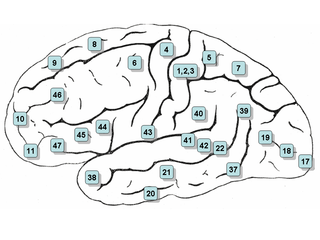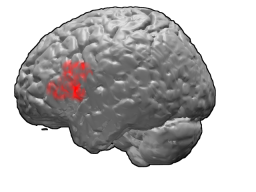
Broca's area, or the Broca area, is a region in the frontal lobe of the dominant hemisphere, usually the left, of the brain with functions linked to speech production.

Neurolinguistics is the study of neural mechanisms in the human brain that control the comprehension, production, and acquisition of language. As an interdisciplinary field, neurolinguistics draws methods and theories from fields such as neuroscience, linguistics, cognitive science, communication disorders and neuropsychology. Researchers are drawn to the field from a variety of backgrounds, bringing along a variety of experimental techniques as well as widely varying theoretical perspectives. Much work in neurolinguistics is informed by models in psycholinguistics and theoretical linguistics, and is focused on investigating how the brain can implement the processes that theoretical and psycholinguistics propose are necessary in producing and comprehending language. Neurolinguists study the physiological mechanisms by which the brain processes information related to language, and evaluate linguistic and psycholinguistic theories, using aphasiology, brain imaging, electrophysiology, and computer modeling.
Lexical semantics, as a subfield of linguistic semantics, is the study of word meanings. It includes the study of how words structure their meaning, how they act in grammar and compositionality, and the relationships between the distinct senses and uses of a word.

Generative grammar, or generativism, is a linguistic theory that regards linguistics as the study of a hypothesised innate grammatical structure. It is a biological or biologistic modification of earlier structuralist theories of linguistics, deriving from logical syntax and glossematics. Generative grammar considers grammar as a system of rules that generates exactly those combinations of words that form grammatical sentences in a given language. It is a system of explicit rules that may apply repeatedly to generate an indefinite number of sentences which can be as long as one wants them to be. The difference from structural and functional models is that the object is base-generated within the verb phrase in generative grammar. This purportedly cognitive structure is thought of as being a part of a universal grammar, a syntactic structure which is caused by a genetic mutation in humans.

Brodmann area 45 (BA45), is part of the frontal cortex in the human brain. It is situated on the lateral surface, inferior to BA9 and adjacent to BA46.

Brodmann area 47, or BA47, is part of the frontal cortex in the human brain. It curves from the lateral surface of the frontal lobe into the ventral (orbital) frontal cortex. It is below areas BA10 and BA45, and beside BA11. This cytoarchitectonic region most closely corresponds to the gyral region the orbital part of inferior frontal gyrus, although these regions are not equivalent. Pars orbitalis is not based on cytoarchitectonic distinctions, and rather is defined according to gross anatomical landmarks. Despite a clear distinction, these two terms are often used liberally in peer-reviewed research journals.

In psycholinguistics, language processing refers to the way humans use words to communicate ideas and feelings, and how such communications are processed and understood. Language processing is considered to be a uniquely human ability that is not produced with the same grammatical understanding or systematicity in even human's closest primate relatives.
The N400 is a component of time-locked EEG signals known as event-related potentials (ERP). It is a negative-going deflection that peaks around 400 milliseconds post-stimulus onset, although it can extend from 250-500 ms, and is typically maximal over centro-parietal electrode sites. The N400 is part of the normal brain response to words and other meaningful stimuli, including visual and auditory words, sign language signs, pictures, faces, environmental sounds, and smells.
Language production is the production of spoken or written language. In psycholinguistics, it describes all of the stages between having a concept to express and translating that concept into linguistic forms. These stages have been described in two types of processing models: the lexical access models and the serial models. Through these models, psycholinguists can look into how speeches are produced in different ways, such as when the speaker is bilingual. Psycholinguists learn more about these models and different kinds of speech by using language production research methods that include collecting speech errors and elicited production tasks.
Sentence processing takes place whenever a reader or listener processes a language utterance, either in isolation or in the context of a conversation or a text. Many studies of the human language comprehension process have focused on reading of single utterances (sentences) without context. Extensive research has shown that language comprehension is affected by context preceding a given utterance as well as many other factors.
In certain theories of linguistics, thematic relations, also known as semantic roles, are the various roles that a noun phrase may play with respect to the action or state described by a governing verb, commonly the sentence's main verb. For example, in the sentence "Susan ate an apple", Susan is the doer of the eating, so she is an agent; an apple is the item that is eaten, so it is a patient.

Andrea Carlo Moro is an Italian linguist, neuroscientist and novelist.
Speech production is the process by which thoughts are translated into speech. This includes the selection of words, the organization of relevant grammatical forms, and then the articulation of the resulting sounds by the motor system using the vocal apparatus. Speech production can be spontaneous such as when a person creates the words of a conversation, reactive such as when they name a picture or read aloud a written word, or imitative, such as in speech repetition. Speech production is not the same as language production since language can also be produced manually by signs.
The P600 is an event-related potential (ERP) component, or peak in electrical brain activity measured by electroencephalography (EEG). It is a language-relevant ERP component and is thought to be elicited by hearing or reading grammatical errors and other syntactic anomalies. Therefore, it is a common topic of study in neurolinguistic experiments investigating sentence processing in the human brain.
Music semantics refers to the ability of music to convey semantic meaning. Semantics are a key feature of language, and whether music shares some of the same ability to prime and convey meaning has been the subject of recent study.

Angela Friederici is a director at the Max Planck Institute for Human Cognitive and Brain Sciences in Leipzig, Germany, and is an internationally recognized expert in neuropsychology and linguistics. She is the author of over 400 academic articles and book chapters, and has edited 15 books on linguistics, neuroscience, language and psychology.
The mental lexicon is defined as a mental dictionary that contains information regarding the word store of a language user, such as their meanings, pronunciations, and syntactic characteristics. The mental lexicon is used in linguistics and psycholinguistics to refer to individual speakers' lexical, or word, representations. However, there is some disagreement as to the utility of the mental lexicon as a scientific construct.
Linguistic prediction is a phenomenon in psycholinguistics occurring whenever information about a word or other linguistic unit is activated before that unit is actually encountered. Evidence from eyetracking, event-related potentials, and other experimental methods indicates that in addition to integrating each subsequent word into the context formed by previously encountered words, language users may, under certain conditions, try to predict upcoming words. In particular, prediction seems to occur regularly when the context of a sentence greatly limits the possible words that have not yet been revealed. For instance, a person listening to a sentence like, "In the summer it is hot, and in the winter it is..." would be highly likely to predict the sentence completion "cold" in advance of actually hearing it. A form of prediction is also thought to occur in some types of lexical priming, a phenomenon whereby a word becomes easier to process if it is preceded by a related word. Linguistic prediction is an active area of research in psycholinguistics and cognitive neuroscience.

A Jabberwocky sentence is a type of sentence of interest in neurolinguistics. Jabberwocky sentences take their name from the language of Lewis Carroll's well-known poem "Jabberwocky". In the poem, Carroll uses correct English grammar and syntax, but many of the words are made up and merely suggest meaning. A Jabberwocky sentence is therefore a sentence which uses correct grammar and syntax but contains nonsense words, rendering it semantically meaningless.
Syntactic bootstrapping is a theory in developmental psycholinguistics and language acquisition which proposes that children learn word meanings by recognizing syntactic categories and the structure of their language. It is proposed that children have innate knowledge of the links between syntactic and semantic categories and can use these observations to make inferences about word meaning. Learning words in one's native language can be challenging because the extralinguistic context of use does not give specific enough information about word meanings. Therefore, in addition to extralinguistic cues, conclusions about syntactic categories are made which then lead to inferences about a word's meaning. This theory aims to explain the acquisition of lexical categories such as verbs, nouns, etc. and functional categories such as case markers, determiners, etc.









